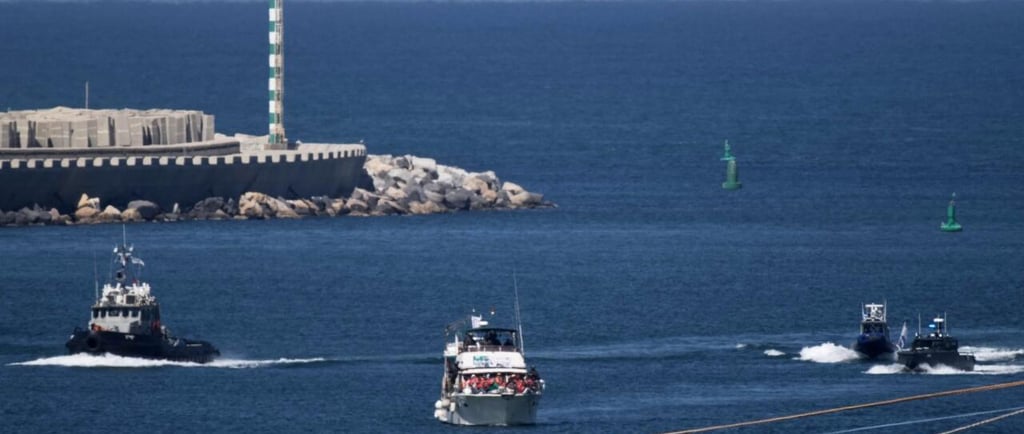GLOBISCOPES
How the Gaza Aid Flotilla Used Cameras, Data, and Digital Tools to Capture Global Attention
ATHENS: As Israeli forces boarded a civilian flotilla carrying humanitarian aid to Gaza on Wednesday night, two software developers in Glasgow were racing against time — tracking every vessel online while millions around the world followed the unfolding drama in real time. Live video from cameras aboard the ships streamed directly on the flotilla’s official website, showing Israeli commandos boarding boats under the cover of darkness. Meanwhile, developers continuously updated the ships’ statuses, posting short clips of each interception. The site’s traffic exploded — with 2.5 million visits on Wednesday and 3.5 million the next day — a record for the project’s creators. > “I’ve never seen numbers like this,” said Lizzie Malcolm, co-director of Rectangle, a Glasgow-based web studio that handled tracking for the flotilla’s organizers. --- A Digital Campaign that Transformed a Protest into a Global Movement The Global Sumud Flotilla, composed of over 40 civilian boats carrying nearly 500 activists, parliamentarians, and lawyers — including Swedish climate activist Greta Thunberg — set sail to challenge Israel’s long-standing naval blockade of Gaza. Although the ships were intercepted and escorted to Israeli ports, the flotilla became a symbolic victory in the court of public opinion. Within ten days, it had evolved into one of the most high-profile international demonstrations against the blockade — inspiring a new fleet of 11 vessels to set sail soon after. Through a mix of social media engagement, real-time tracking technology, digital storytelling, and community organizing, the movement drew massive global attention and reignited calls to lift the siege on Gaza. --- Global Reaction: From Street Protests to Political Statements Israel maintains that the blockade, first imposed in 2007 after Hamas took control of Gaza, is a legal security measure. Yet, its interception of the flotilla triggered widespread condemnation and protests from Europe to Latin America and South Asia, with solidarity marches erupting in Argentina, Mexico, and Pakistan. World leaders and lawmakers from Colombia, Malaysia, and the UK voiced criticism, amplifying the flotilla’s message. Experts say this momentum reflects a wider political shift since mid-2025, when countries such as France and the United Kingdom recognized Palestinian statehood following Israel’s escalating military campaign in Gaza. > “The cultural impact is clear — movements like the flotilla are shaping how the world sees this conflict,” said Dan Mercea, Professor of Digital and Social Change at St. George’s, University of London. --- From a Small Idea to a Global Network The origins of the Global Sumud Flotilla trace back to June 2025, when several activist groups — including March to Gaza — met in Tunis to coordinate efforts. Their conclusion: isolated campaigns were not enough. A larger, more coordinated action was needed. > “We realized that something bigger had to happen — not just protest, but a message the world couldn’t ignore,” said Antonis Faras, a member of the Greek delegation. The response was overwhelming. Within days of announcing participation, organizers received 20,000 applications from volunteers. In Italy, the humanitarian group Music 4 Peace aimed to collect 40 tons of supplies, but donations exceeded 500 tons in just five days. Across Europe, local teams prepared fleets — Greece assembled 25 boats, while unions in Italy pledged logistical and financial support. Their efforts culminated in a massive general strike on October 3, after Israeli forces intercepted the flotilla. > “Each region built its own communication and press network — that’s why protests were so quick and coordinated,” explained Maria Elena Delia, spokesperson for the Italian delegation. --- Livestreams and Digital Storytelling: A New Kind of Resistance The flotilla’s communication strategy was cutting-edge. Activists broadcast live updates on X, Telegram, and Instagram, while journalists joined Zoom press conferences hosted from the ships. Among the passengers were Greta Thunberg and Nelson Mandela’s grandson, whose presence drew international media coverage. Cameras installed onboard provided a real-time window into the Israeli interception, showing activists sitting in life vests with hands raised as soldiers boarded the ships under night vision. In Glasgow, Malcolm and her partner Daniel Powers, in collaboration with London’s Forensic Architecture research group, used redundant tracking systems, including Garmin GPS devices and mobile backups, to ensure continuous coverage even if primary connections failed. > “People wanted to see what was happening,” Malcolm said. “There’s something powerful about watching it live — you find yourself rooting for them to reach Gaza.” --- A Digital Blueprint for Global Solidarity The Global Sumud Flotilla may not have breached the blockade, but it redefined digital activism in the Palestinian solidarity movement. Through coordinated storytelling, open data, and real-time transparency, activists transformed a local protest into a worldwide event of conscience. As new boats set sail, the flotilla’s organizers continue to demonstrate how technology, media, and human determination can unite millions across borders for a shared humanitarian cause
WORLD
Globiscope
10/5/20251 min read


My post content
Globiscopes news 2025
Globiscopes news empowers the generation of tomorrow for a brighter future and hope for every individual.
inbox
Subscribe to our newsletter and never miss a story.
We care about your data in our privacy policy.
